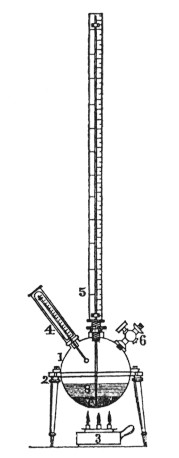Francois Marcet's Steam Globe
Today, a piece of apparatus and a piece of history. The University of Houston's College of Engineering presents this series about the machines that make our civilization run, and the people whose ingenuity created them.
An unexpected article by Theodore Sterling in Rittenhouse's Journal of Scientific Instruments: The title, "Marcet's Apparatus," calls to mind the great early-19th-century textbook writer, Jane Marcet. But this item is credited to François Marcet. Who is he?
First the article: It's about an instrument for measuring the vapor-pressure of water. A small spherical boiler is fitted with a thermometer and a long mercury manometer. You half-fill it with water, then heat it. The thermometer and manometer give a sequence of pressures and the matching boiling-point temperatures. The instrument is limited by the height of the manometer. If it's 2½ feet high, you can measure up to twice atmospheric pressure. If it's five feet high, you can go to three atmospheres, and so on.
Marcet probably built this device around 1826 when he was only 23. If that date is correct, François Arago of the French Academy of Sciences had done the same experiment three years earlier. Arago mounted sections of pipe up the side of a church tower and managed to measure water-vapor pressures to 24 atmospheres. Author Sterling tries to determine whether Arago or Marcet originated the idea. He decides Arago was probably first.
But I thought there might be more to the story of François Marcet, so I did some looking of my own. Marcet was born in England, where he went by the name of Francis. But he was living in Switzerland when he did the experiments. It turns out that Jane Marcet was his mother. She wrote her first book, Conversations in Chemistry, when he was a toddler. Jane Marcet's husband, Alexander, was a noted Swiss physician. The family spent time in both countries.
Jane Marcet was the focal point for women scientists in England. She was well-connected, and Arago was one of her European scientific friends. That apparatus was almost certainly the fruit of shared ideas, and its significance reached beyond measuring water's boiling points.
Jane Marcet and François Arago both used technology as a vehicle for social reform. She did much to take women out from behind the "Crinoline Curtain." He strove to bring the Industrial Revolution to France, and that meant getting the French to adopt the new English steam engines. James Watt had been among the first to measure vapor-pressures. Now both Arago and Jane Marcet's young son were trying to improve that basic engineering information.
In 1872, Francis Marcet (now 69 years old) edited a 14th edition of his mother's physics book. By then steam engines were running at far higher pressures than Marcet's, or even Arago's, apparatus could reach, and those engines had transformed us. But the apparatus was still a part of college courses. Jane Marcet's books were still teaching students in those courses. And France had, at last, become a major steam-driven industrial nation.
I'm John Lienhard, at the University of Houston, where we're interested in the way inventive minds work.
(Theme music)
Sterling, T.C., Marcet's Apparatus. Rittenhouse: Journal of the American Scientific Instrument Enterprise, Vol. 8, No. 4, 1994, pp. 110-113.
Marcet, J.H., Conversations on Natural Philosophy. Boston: Lincoln, Edmonds & Co., 1834. (This is one of many later editions of Marcet's book. This particular edition bears the name of J.L. Blake on its title page.)
I am grateful to Helen Coffeen for providing me with issues of Rittenhouse and urging me to do programs from their pages.
For more on Jane Marcet see Episodes 741, 744, 745, 828, and 950. For more on François Arago, see Episodes 691, 704, and 1296.
This episode was written in 1998. In a 2010 email, Dr. John S. Reid, of the University of Aberdeen Physics Dept., provided this fascinating addition: "You mention a possible date of invention of 1826. ... Our University accounts record the purchase for teaching demonstration by the Professor of Natural Philosophy at Marischal College, Aberdeen, of 'Marcet's steam apparatus' from the London maker/supplier Al. Garden in the 1824/25 accounts. If it was being made in London then, it's invention in France must have been a year or two earlier. We have a version in almost pristine condition by Watkins and Hill, London instrument makers who were in existence at that time, in our historic scientific instrument collection derived from the University's teaching demonstration apparatus."

François Marcet's vapor-pressure measurement apparatus
From Illustrations of Chemical Apparatus, 1846